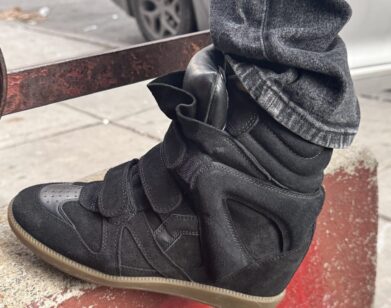Cédric Charlier Is an Island of Calm in Paris
It’s the day before the third Paris show for his namesake collection, and Belgian designer Cédric Charlier is more than calm, reviewing the 30-odd silhouettes he will parade at the Palais de Tokyo on Tuesday afternoon. At Charlier’s side is his friend and mentor Tony Delcampe, director of La Cambre fashion academy in Brussels, who counts not only Charlier but also Anthony Vaccarello and Theory’s Olivier Theyskens amongst his school’s alumni. Together the pair watches as a hairstylist crafts a meticulous swept-back beehive, a key reference for tomorrow’s show that will traverse, in Charlier’s own words, “a contemporary mediaeval. It’s about the sophistication and purity of illuminated manuscript.”
But you can put to rest any unwanted visions of chainmail straitjacket hybrids or gold leaf. Charlier is a subtle guy, and his heroine an unlikely candidate for excess—however, fur and embroidery do make their first appearance in his lineup for Fall/Winter 2013. The translation lies more in the precision of the medieval calligraphy against the unbridled emotion of the outsider art movement—a box-pleated collar peeking out from a paint-splattered perfecto, for example.
Perhaps it’s a freedom from the tunnel vision of a “house heritage,” yet since his exit from Cacharel in 2011, Charlier’s work has flourished. Deconstruction, a somewhat constant obsession of the Belgians, is given an uptown polish under his deft hand. “It’s about the ‘truth’ of the body, but at the same time, an enveloping architecture. The attitude is sophisticated but subversive,” he explains, fondling the inverted piping that trails down the spine of a sleek waistcoat dress. This ‘polish’ has not gone unnoticed this past year, with major retailers including Barneys, Fred Segal, and The Webster Miami quickly snapping up both runway and pre-collections—clothes that stem from myriad eferences without ever quite straying into the avant-garde.
“A feminine allure is integral to my work,” says Charlier, “and the first season was about the dress, the jacket, the coat. After three seasons, now I can work deeper with the opposition of materials, with overlay and a study of matte and shine.” He’ll play out that research tomorrow to a soundscape of ambient noise and ’70s glam rock, in yet another riff on his calm-versus-chaotic agenda—one that should leave both editors and retailers more than happy amidst these final days of a long, snowy fashion month.







